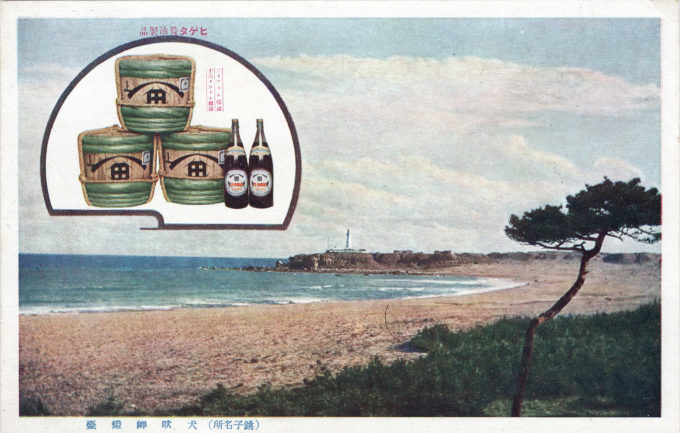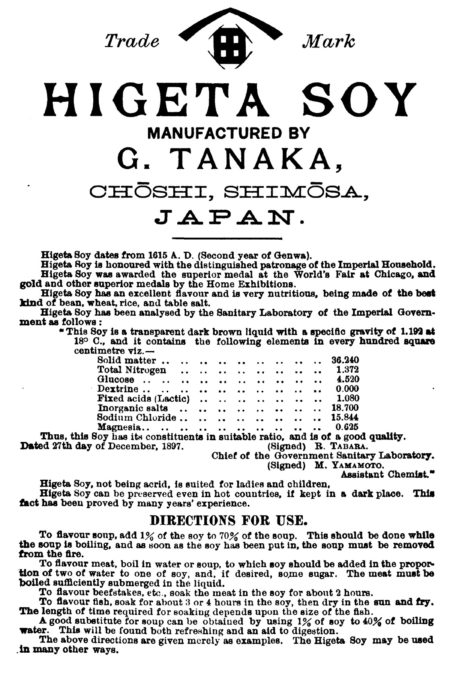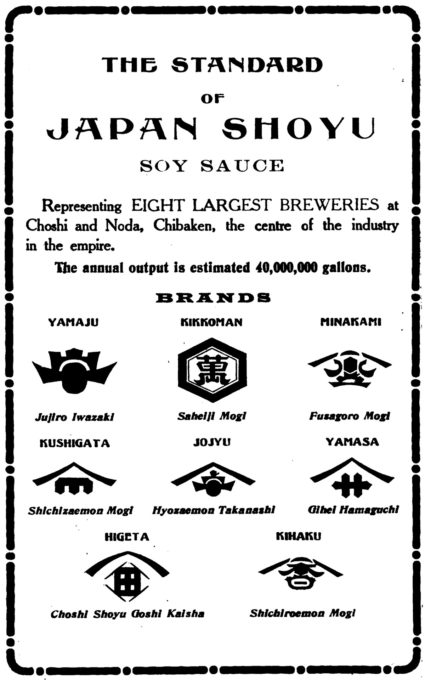“Higeta shoyu is one of the oldest brands of soy sauce in Eastern Japan, tracing its history back to 1616 when Tanaka Genba, a dried sardine trader, began making shoyu in Choshi, a coastal town at Cape Inubō on the Pacific coast of the Boso penisula. Tanaka then transported his shoyu to the feudal capital of Edo by flatboat.
“A year earlier, the Hamaguchi brothers migrated from Kii province (modern-day Wakayama prefecture), the birthplace of shoyu in Japan, to Choshi. The elder of the brothers soon established Hiroya, a food distribution company, in the capital; the younger brother located to Choshi to venture into the production of Yuasa-branded shoyu.
“In 1914 the Hamaguchi brothers joined Tanaka along with another Chochi shoyu maker, Fukui Kichibei, to form Choshi Shoyu Co. Ltd. Each family continued to produce their own brands of shoyu but around 1925 Higeta, which had been Tanaka’s brand, became the sole company branded product. An ambitious plan of expansion was drafted soon thereafter to leapfrog Higeta over the Yamasa shoyu brand, its local rival begun in 1645. But Higeta became overextended and by 1937 Kikkoman stepped in to purchase 80% of Higeta’s outstanding shares.
“As Higeta was brought into the fold of Kikkoman companies the involvement of the original investors changed. Tanaka gradually withdrew. The Fukui family remained active in the company until the 1970s, but then they too withdrew.
Chiba Prefecture shoyu manufacturers, 1915, including Higeta-brand. [Source: Japan and Her Exhibits at the Panama-Pacific International Exhibition booklet]
“Higeta still leads Japan in shoyu production know-how. It was the first maker to automate the koji culturing process, reducing the labor force needed for this stage from 250 to 30 people. Even though Higeta is the fourth best-selling shoyu in Japan, it still ranks as the third largest maker. The difference is explained by the fact that Higeta’s production excellence is so well established that many firms buy filtered but unrefined shoyu from Higeta to brand as their own product. Even Kikkoman is not above buying shoyu from Higeta to sell as its own.
“Nevertheless, the lack of marketing muscle means that most Japanese today only sample Higeta in their favorite noodle shops.”
– History of Soy Sauce: Extensively Annotated Bibliography and Sourcebook, compiled by William Shurtleff & Akiko Aoyagi, 2012

Cape Inubosaki lighthouse, Choshi, Chiba Prefecture, Higeta Shoyu Co. advertising postcard, c. 1930. Higeta Shoyu was founded in 1616 in Chiba, Japan, the oldest shoyu brewery in the Kanto region. In 1900, Higeta was appointed as the official soy sauce of the Imperial Family. The inset image displays Higeta shoyu packaged in 2-liter bottles and 16-liter casks (komodaru).
See also:
Kikkoman brand Soy Sauce (history), c. 1930.
“A View of a Lighthouse from the Bentenbashi Riverbank”, Yokohama, c. 1910.
Modern Lighthouse, Niigata, c. 1930.
“Inubōsaki Lighthouse (犬吠埼燈台, Inubōsaki tōdai) is a lighthouse on Cape Inubō, in the city of Chōshi, Chiba Prefecture Japan.
“Although not one of eight lighthouses to be built in Meiji period Japan under the provisions of the Anglo-Japanese Treaty of Amity and Commerce of 1858, signed by the Bakumatsu period Tokugawa Shogunate, the need for a lighthouse at Cape Inubō for the safety of vessels on the northeastern approaches to Tokyo was recognized at an early time after Japan was opened to the West. The wreck of the Tokugawa navy warship Mikaho in a typhoon on the rocks of Cape Inubō with the loss of 13 lives on October 6, 1868 further emphasized the need for a lighthouse.
“The lighthouse was designed and constructed by British engineer Richard Henry Brunton, born 1841 in Kincardineshire, Scotland, who was under contract by the new Meiji government. Brunton constructed another 25 lighthouses from far northern Hokkaidō to southern Kyūshū during his career in Japan.
“The structure consisted of a cylindrical tower made from the first domestically-produced red bricks in Japan. Brunton supervised the construction of a brick factory in Tomioka Village in what is now part of Narita City, which produced 193,000 bricks for the project. However, Brunton was uncertain of the mechanical strength of the Japanese bricks, so he constructed the tower using a double thickness for the walls.
“The tower, at 31.5 meters, is also the second tallest brick lighthouse in Japan, surpassed only by the Shiriyazaki Lighthouse (also built by Brunton) in Higashidōri, Aomori Prefecture.
“The Inubōsaki Lighthouse was first lit on November 15, 1874.”
– Wikipedia



